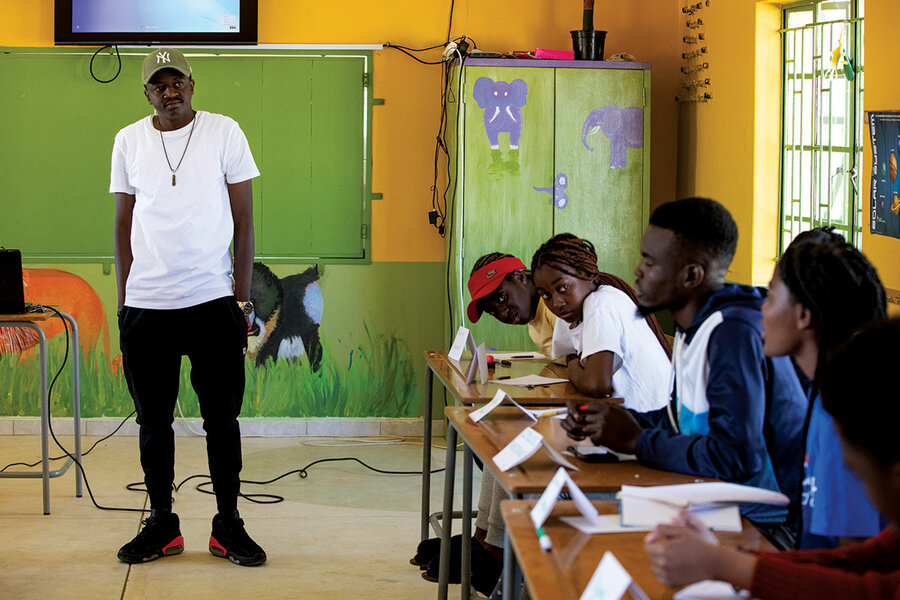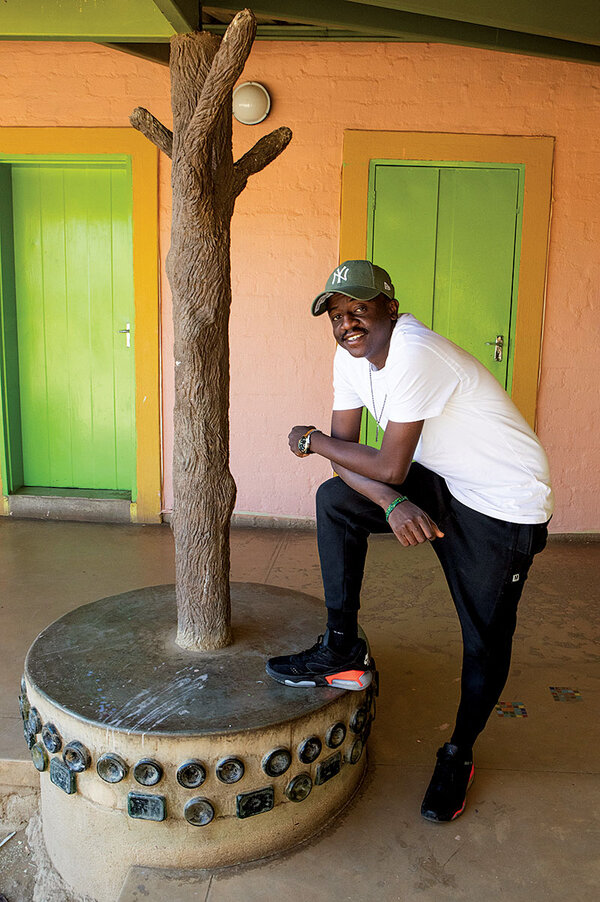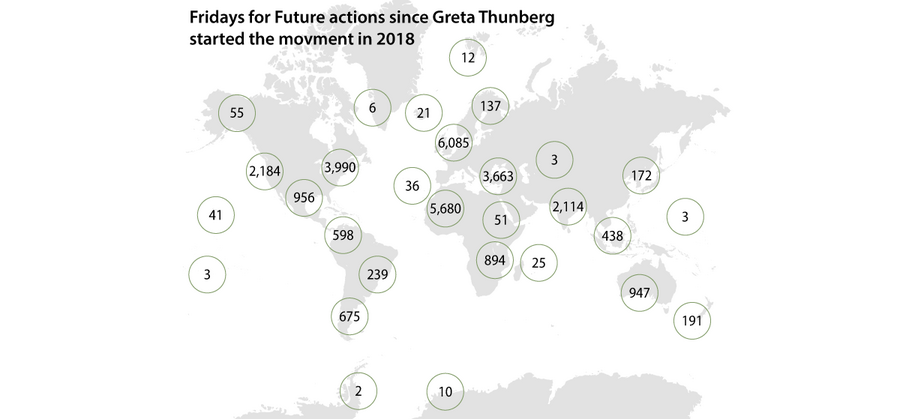His gift of gab and hope may determine the temperature of your world
Loading...
| Windhoek, Namibia
Deon Shekuza is a peripatetic and charming climate influencer – as comfortable proselytizing green energy to youth on the hardscrabble roads and villages of this former German colony as he is in Namibia’s government ministries and the halls of United Nations conferences.
Paid with respect if not a salary, he’s part of a rising breed of young climate activists across the Global South. They are an important force, says Myles Allen, director of the University of Oxford Net Zero initiative, that could take on government roles and “be the ones making the decisions that will determine what temperature we end up at.”
Why We Wrote This
A story focused onIn a solar- and wind-rich nation bent on being the hub of renewable energy in Africa, a peripatetic climate activist models the responsibility a generation feels for the world. Part 2 in a seven-part series.
Climate activism is often seen as a Western middle-class movement. But across the Global South, youth are voicing the same anxieties over climate change. For activists across Namibia – like the Arctic Inuit, or youth on small island nations – caring and conserving is the easy part. They grew up living sustainable lives before it was trendy.
Mr. Shekuza and young activists like him across Africa are part of the Climate Generation, as we’re calling the cohort born since 1989, when consciousness of children’s rights and global warming intersected.
They recognize, says Mr. Shekuza, that “there’s often opportunities where there is crisis.”
Deon Shekuza is a peripatetic and charming climate influencer – as comfortable proselytizing green energy to youth on the hardscrabble roads and villages of this former German colony as he is in Namibia’s government ministries and the halls of United Nations conferences.
Paid with respect if not a salary, he’s part of a rising breed of young climate activists across the Global South whose work, suggests one climate expert, may well determine the temperature of your world.
Africa, which has contributed least to climate warming, is the continent most threatened by the droughts, floods, and heat intensified by climate change. In that extremity, the relentlessly positive Mr. Shekuza sees great opportunity for progress for Namibia.
Why We Wrote This
A story focused onIn a solar- and wind-rich nation bent on being the hub of renewable energy in Africa, a peripatetic climate activist models the responsibility a generation feels for the world. Part 2 in a seven-part series.
In the dusty chaos of an informal settlement on the edge of this capital city one recent morning, he faces his biggest challenge: capturing the imaginations of young teens on a complex topic. The kids have gathered in a bright community center classroom, not for school credit and certainly not for fun on their Saturday off, but to hear Mr. Shekuza teach green hydrogen 101. Namibia has staked its future on this next big solution for a global clean energy transition.
It’s touch-and-go for Mr. Shekuza – who himself came from a poor village, born in 1990 when climate change was just becoming a global concern. His cool factor – a New York Yankees cap and Nike basketball shoes – isn’t making up for the intricacies of environmental acronyms, policies, and economics. His words fly straight over heads dutifully bowed in note-taking posture.
No one here knows what green hydrogen is, let alone how it might be the route to social justice that Namibia’s leaders proclaim.
Grasping for something understandable, Mr. Shekuza gestures out the window at the ancient and humble street scene of women laden with bushels of branches gathered from the forest for heating and cooking fuel. “This is exactly what we do not want for our people, right? Some energy sources keep you in the past, and some energy sources move you into the future. This is why we are here talking about green hydrogen.”
After 90 minutes, Mr. Shekuza is satisfied. These kids might not exactly understand Namibia’s renewable energy policy, but they understand green hydrogen potential: jobs for them in a new economy that could turn Africa’s perpetual sunlight into clean fuel for electricity and transportation here and for export.
“As the young future leaders or future businesspersons or innovators,” he says, “you need to think about these things, because there’s often opportunities where there is crisis.”
Activism is for survival, not a moral obligation
Climate activism is often seen as a movement of the Western middle class – of young Swedish activist Greta Thunberg scolding older generations. But across the Global South, young people are voicing the same anxieties over climate changes, extreme weather events, and how they affect their future.
For activists across Namibia – like the Inuit in the Arctic, or youth from small island nations – caring and conserving is the easy part. These youth grew up living sustainable lives well before it was trendy. Many were born on the land, in the bush, on the coast, with no playgrounds except the natural environment around them. They conserved not for environmentalism, but for survival.
They are not, like their peers in the industrialized world, driven by a sense of moral obligation. Instead, they’re on the front lines of the crisis already. And their voices in the global fight have made it harder to dismiss youth climate activism, as some do, as a protest of unrealistic, privileged children.
Mr. Shekuza and young African activists like him across the continent who are part of the Climate Generation, as we’re calling it, see a chance – the kind Mr. Shekuza tells the children in the informal settlement to seize, the kind he has seized for himself.
These activists “have massive potential influence because I think everybody recognizes that it’s the youth and particularly the youth in the Global South that are really going to be primarily affected by the climate crisis,” says Myles Allen, director of the University of Oxford Net Zero initiative and an author of the landmark 2018 U.N. scientific report, “Global Warming of 1.5 °C,” documenting immediate impacts of global warming.
“If we do what we say we’re going to do, then Europe will become a diminishing contributor to the global issue, whereas a country like Nigeria or Namibia, for that matter, may be a rapidly growing one,” he says. “So as these new activists take on roles in government, they’re going to be the ones making the decisions that will determine what temperature we end up at.”
Mr. Shekuza can barely afford to do the work he has cut out for himself.
For all his social confidence, he hesitates at the doorstep of his home before inviting visitors in for the first time ever.
Descending from sunny daylight down a step at the side of a large old house, he enters the tiny basement space he shares with his mother.
With a revealing flourish of humility, he pulls the worn blue curtain separating his mother’s bed from his floor space: “This,” he says, “is climate activism in Africa.”
In his windowless corner lies his bed, a tattered pad on the floor encircled by stacks of climate policy documents and the King James Bible, which he reads each morning and night. On the chipped yellow paint of a cement wall are dozens of badges from U.N. conferences. A single business suit hangs from the curtain rope.
This is the headquarters of his nongovernmental organization. With just the grants and fees he cobbles together from government and U.N. funding, the 33-year-old college dropout educates himself, hatches ideas for mentoring youth, and speaks via Zoom to august groups, all on the floor here. For an online speech on climate justice for a British Museum conference, he had no option but to give his speech right there, cross-legged on his sleeping pad, dressed in a traditional African tunic, surrounded by clothes, caps, shoes, and all of his policy documents.
He picks up a tattered DVD of a 2003 animated “David and Goliath” that he watches often: “I see myself in little David because I feel like, you know, you have a big heart. ... And Goliath is now climate. It’s a big, big challenge.”
The environment, he says, was always a part of his interest: Nature was his escape from the noise and dilapidation of poverty in his rural hometown of Grootfontein. His earliest memories are of wandering the countryside, drawn up to the town’s welcome sign on the hills where he could survey the shrubs and grassland growing in the dry season, and dams filling with water in the rainy season.
“We are people who never look at the environment like something that is separate, because you grew up looking at it as part of you,” he says.
As he entered high school, environmentalism and conservation became part of his lexicon. They were suddenly discussed as one of the world’s pressing issues – and just as suddenly became his career trajectory.
A kid who always liked the big questions – and with a sense that he was destined for something bigger than his small life – he signed up for courses on renewable energy. He learned that Namibia, where the Kalahari Desert meets plateaus that descend into the Namib Desert and finally the Atlantic Ocean, has a role to play with its unrivaled wind and solar potential.
In the process, he identified his personal path: “We come from a past that is already disadvantaged. And for me not to continue the social justice fight for a better humanity would ignore those who fought for me to have the rights I have right now. It’s just my struggle is not the same as theirs. It’s not slavery or apartheid today,” says Mr. Shekuza. “In our day, for my generation, the environment has presented itself as the challenge of our era.”
He co-founded the NGO Namibian Youth on Renewable Energy (NAYoRE); gave himself the title “youth advocate for sustainable development”; worked with other organizations and networks on biodiversity, farming, and climate change; and started crisscrossing the globe on invitations to attend and address government, U.N., and private conferences.
He never finished his environment and geography studies at the University of Namibia because he was too busy with social activism. He often mentions his conflicting feelings about this – maybe he shouldn’t be where he is as such a powerful influencer, yet, “with a degree, I’d be working 9-to-5 for an institution.”
He explains, sitting on his sleeping mat: “This is how I know that what I’m saying is correct, because they may see me with a fancy English up here, but my lifestyle is no different from that kid in the shack. So when I speak for the youth, I’m coming from experience and I’m speaking something solid.”
He pulls out a binder on agriculture in Namibia and how to use regenerative practices in one of the most water-stressed nations on the planet. It’s the latest document he’s read, and he’s read all of it: “I have dedicated hours and hours and hours ..., like trying to upgrade and upskill myself. And I did that in and out of school, but I found the most benefit came out of it.”
Though climate change activism has given him purpose, it’s almost a detriment to himself – and his mother.
Renneth Shekuza is a deeply religious woman who works long hours for her Pentecostal church running a food bank, cleaning toilets, and doing anything else that’s needed. Her son is solicitous of her, letting the fan they share blow in her direction in their sweltering room and taking it hard that he has no money to replace her broken TV.
She tears up outside their home in Hochland Park – an area Black residents were forced from under apartheid – and says she thanks God for the work her son does: “I know that one day God is going to lift him up.”
With an arm around her, Mr. Shekuza reassures her: “One day the dots will connect.”
He says he’s spiritual but no longer religious, and adds that even as God guided David’s aim of the sling, “God guides my tongue whenever I speak.”
Clean energy is this generation’s “moonshot”
Indeed, Mr. Shekuza’s charming gift of gab animates his activism.
On a late Friday afternoon, Mr. Shekuza meets at a cafe with Micky Kaapama, whom he has been tutoring to be a climate activist, or, as they put it, a “biodiversity enthusiast.” The glamorous fashion model studied biology and, crucially, has 12,000 Instagram followers.
Thinking big, as he does, Mr. Shekuza openly shares a vision of the intersection of gender dynamics and climate. “Imagine she writes [on her social media], ‘I like a man who understands the value of biodiversity.’ ... Then the guy will have to start reading,” he says, quickly dropping his formal manner for the lingo of youth: “If you are going to mack on her, you have to know your basics.”
As if trying to convince her of what she has to gain, he pulls out his phone to show an invitation from the Namibian president’s office that he’s just received. Addressed to Deon Shekuza, “Youth Advocate for Sustainable Development,” it’s for a luncheon with Hyphen, a German- and British-financed Namibian company that signed a deal last May with Namibia to build the largest green hydrogen project in the country. It’s an $11 billion agreement – almost the size of Namibia’s annual gross domestic product.
His tutee is suitably impressed: “He wants to introduce me to the people that are in charge of this type of event so that I can create a space also for myself,” says Ms. Kaapama.
But there’s a hitch in the impressive invite. He has no idea how he can even afford to get to the event five hours away in Keetmanshoop.
He may be recognized by the president as a player, but he earns little working to support Namibia’s 2021 declaration of itself as a climate leader. The country pledged to cut its emissions by a startling 91% by 2030 – and green hydrogen is one part of the plan.
It’s a bold experiment for an extraction economy. With its vast deposits of diamonds, uranium, copper, lead, tin, lithium, and zinc, it is Africa’s eighth-richest country by per capita GDP. But it ranks second in economic inequality, a legacy of apartheid and a resource economy that has made some Namibians very rich while many remain poor.
So when green hydrogen emerged in the past five years as a solution in a sustainable energy transition and net-zero emission economies, Namibia joined that movement. The U.S. Department of Energy has likened the race to clean energy solutions as this generation’s “moonshot.” And Namibia has the resources for it: 300 days a year of full sunshine and an abundance of wind, coast, and sparsely populated land. That’s all it needs to produce green hydrogen, or energy generated by renewables. (The process, simply put, would use solar or wind power to extract hydrogen molecules from desalinated seawater, producing green ammonium that would be used for regional and global fuel markets to power transportation and electricity production.)
Namibia named a green hydrogen commissioner and quickly created what Jabri Ibrahim, a Kenya-based specialist for the U.N. Climate Change High-Level Champions, calls a “wealth creation story” around green hydrogen. The budding sector needs safeguards, but the story “really resonates with a growing number of young Africans,” he says. “Many believe aid is not able to transform a country to prosperity in a way markets do. African youth want innovation and African leadership.”
The buzz around green hydrogen in Namibia right now has the feel of a startup. The University of Namibia has opened the Namibia Green Hydrogen Research Institute, with dozens of academics studying the challenges and benefits of a green hydrogen market. Vocational schools are trying to introduce new curricula in solar and wind for green hydrogen production. In addition to the Hyphen project, others are taking shape here, from plans to power tugboats with green hydrogen in Walvis Bay, to the construction of the Daures Green Hydrogen Village, a net-zero village powered by green hydrogen.
“It’s exciting,” says Aina Kauluma, an energy analyst for the Daures project who is getting a master’s degree in renewable energy at the University of Namibia. “Africa has the resources and the open land and can actually help mitigate climate change through renewable energy resources.”
Indeed, the promise of green hydrogen is irresistible to Mr. Shekuza, who has come to see it as a propulsion force out of colonial harm.
So, Mr. Shekuza decides the presidential invitation for the Hyphen project is too good to pass up.
On the night before the event in late July, he headed to the bus station in central Windhoek. But there was no space on the single bus leaving that night. So, he finally asked a friend for money and called a car service, at midnight, paying about $150.
Hardly anyone at the luncheon would know how stressed he was about how he’d pay back the money. He had his photo taken, in a smart black overcoat, a broad smile spreading across his face.
In black-and-white divide, he chooses to be green
Because he believes in signs and symbols, it’s meaningful to Mr. Shekuza that the year he was born – 1990 – was the year Namibia gained independence, making him a part of the post-apartheid “born frees” generation.
“I come from a place that divided me between black and white, so I choose to be green,” he says, always seeing climate through a lens of justice and equality in this nation where white people dominate business and land ownership despite making up about 6% of the population.
Green hydrogen, however, is divisive – and Mr. Shekuza is able to reconcile his passion for it with a shrewd centrist practicality.
Just a year after the nation’s green hydrogen goals were announced, rich oil and gas discoveries off the Namibian coast fueled skepticism of whether Namibia could or should lead a major green hydrogen export market that doesn’t even exist yet.
Pursuing the “hype” of green hydrogen instead of the reality of oil and gas discoveries, asserts retired banker and miner Steve Galloway, is “dancing to the tune of the Global North.”
Likewise, there are skeptics in unexpected places.
Green hydrogen is a new form of foreign extraction under a green guise, says Veruschka Dumeni, part of the Windhoek branch of Fridays for Future (FFF), the global climate movement started by Ms. Thunberg. The group found allies in the British royal family and Leonardo DiCaprio while fighting
ReconAfrica, a Canadian company drilling for oil in the Okavango Delta watershed.
“You see the Global North countries trying to achieve their own climate ambitions by carbon outsourcing, coming to other countries, and then extracting uranium to develop their nuclear power plants so that they can diversify their energy grid, or the green hydrogen to also meet their own climate targets,” says Ms. Dumeni.
Instead, she believes the Global North should be focused on the goals of “loss and damage,” a term used on the U.N. circuit to mean that those least at fault for climate change should be compensated for their suffering as the most affected.
“At a time when we should be getting climate financing as vulnerable communities to reduce our climate vulnerability, we get investment that is in the form of extraction,” she says.
Mr. Shekuza has no patience for this line of argument. He agrees that big questions remain around green hydrogen and need answers. And he believes that FFF activists raise good points. But the country can’t wait, he argues. “We have to leapfrog, or we will be left behind.”
So he prefers to focus on positive solutions, he says, from the center. He often criticizes the government as “those guys,” even if FFF activists suggest he’s “with” the government.
“What I like about Deon is that he’s not affiliated,” says Panduleni Haindongo, a sustainable development educator in the Atlantic coast city of Swakopmund, where many green hydrogen pilot projects are slated.
Dr. Allen, the Oxford climate expert, agrees with Mr. Shekuza that Namibia can walk both roads – pursuing green energy as well as fossil fuel production.
“We think Namibia is in a really interesting position on this because it’s a country with strong climate ambitions,” says Dr. Allen, who is showcasing the potential of carbon dioxide disposal technologies for future fossil fuel producers at a sideline event starting at the end of this month at the annual global climate summit, COP28. “They are at a crossroads. And,” he adds, echoing the notion that activists like Mr. Shekuza across the developing world will ultimately determine the temperature of Earth, “in a sense, what Namibia decides to do almost sums up the entire global decision.”
When Mr. Shekuza went to his first COP in Morocco in 2016, he slept on a bench at the airport because he didn’t know how to maneuver the per diems he was entitled to as a youth delegate.
“I didn’t know these things,” he says. “All I thought was, ‘I’m going to the climate conference. Please, please, I want to go.’ ... I’m doing something great for the environment.”
It was only when the Namibian environmental minister saw him stuck at the airport that he was able to find his way to a hotel.
“Sometimes I feel I was born on the wrong side of the world,” he says. Being an African climate activist is harder than being a European one, like Ms. Thunberg, who can afford to skip school, he adds. “I would like to think if I were anywhere else, I would be 20 times bigger than this. I would like to say this is where they need me most ... but this is not where I will win most.”
Still, the climate crisis is a platform for African progress in ways the fight against apartheid and efforts to limit the ravages of resource extraction weren’t. That, he says, is because everyone in the world has a stake in global warming – a shift in perception that climate activists like Mr. Shekuza have helped spur.
He heads to Dubai, United Arab Emirates, for COP28 this month – an official youth representative and junior negotiator in the Namibian delegation.
He’ll be wearing that suit that hangs on the curtain rope, carrying his Bible, sleeping comfortably in a hotel room – and he’ll have so much to say.






















